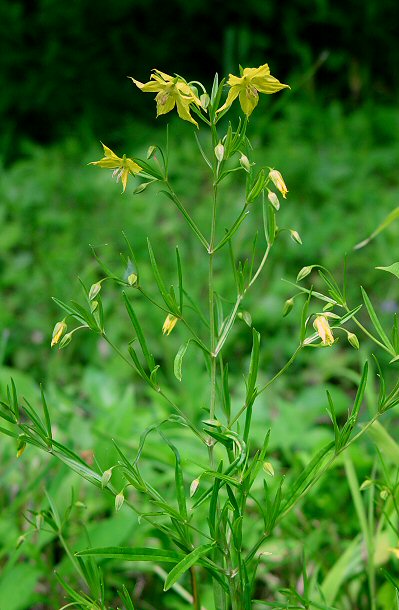Lysimachia quadriflora Sims
Narrow-Leaved Loosestrife

Native
CC = 8
CW = -5
MOC = 34
© DETenaglia
Lysimachia quadriflora SimsNarrow-Leaved Loosestrife | |
 |
Native CC = 8 CW = -5 MOC = 34 |
© DETenaglia |
|
Family - Primulaceae Habit - Perennial forb with elongate, slender rhizomes. Stems - Strongly ascending to erect, to 70 cm, 4-angled, relatively slender (2-3 mm in diameter at the base), unbranched or short-branched above the midpoint (but usually with very short branches represented by dense clusters of leaves at many of the nodes), glabrous.
Leaves - Opposite, simple, entire. Basal leaves rarely present at flowering, shorter than the stem leaves, long-petiolate, the blade elliptic to obovate. Stem leaves opposite, sometimes appearing whorled because of the dense clusters of leaves in the axils, sessile or nearly so. Leaf blades 3-9 cm long, 0.2-0.6 cm wide, linear to very narrowly lanceolate, the bases angled or tapered, angled or somewhat tapered to a sharply pointed tip, the margins entire, usually curled under, glabrous or with a few, long, spreading hairs at the base, glabrous, the upper surface green to dark green, shiny, the undersurface slightly lighter green, dull, with a single prominent midrib; secondary veins not evident.
Inflorescences - axillary from the uppermost nodes, of solitary flowers, the flower stalks 0.5-3.5 cm long, glabrous. Upper internodes very short, creating a whorled appearance. Flowers nodding.
Flowers - Calyces mostly 5-lobed, the lobes 4-6 mm long, lanceolate, not gland-dotted or punctate, usually with 3-5 evident veins. Corollas mostly 5-lobed, the lobes 7-10 mm long, obovate to rhombic-elliptic, angled or slightly tapered to a sharp, sometimes extended point at the tip, the margins otherwise entire or slightly uneven, yellow, densely glandular and with reddish markings on the upper surface toward the base, lacking purple spots or lines. Stamens 5, shorter than the corollas, the filaments 2-3 mm long, not fused into a basal tube, glandular-hairy. Staminodes alternating with the stamens, slender or somewhat broadened toward the base. Styles 4-5 mm long. Ovary superior, subglobose, green, glabrous, 5-valved, 1.2 mm in diameter. Placentation free-central.
Fruits - Capsules 3.5-5.0 mm long, 5-valved, broadly ovoid to globose. Seeds 1.1-1.4 mm long, irregularly elliptic, oblong, or rhombic in outline, triangular in cross section with 1 side somewhat concave, dark brown to reddish brown, shiny. Flowering - June - August. Habitat - Fens, bases and ledges of bluffs, seepy streambanks, bottomland forests, swamps; usually on calcareous substrates. Origin - Native to the U.S. Lookalikes - Broadly, other species of Lysimachia. Other info. - This species can be found in the south-central counties of Missouri. The Missouri populations are somewhat disjunct from the plant's main distribution, which is in the upper Midwest and parts of Canada. The plant is easily identified by its very narrow, opposite leaves, its falsely-whorled flowers, and the wet habitat it prefers. This is primarily a fen species, and it also prefers calcareous soils. The flowers can sometimes be white in color. Photographs taken along the shores of the Current River, Shannon County, MO., 7-6-03 (DETenaglia); also at St. Francois State Park, St. Francois County, MO, 6-19-2017 and 6-27-2022 (SRTurner). |